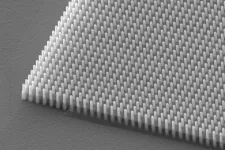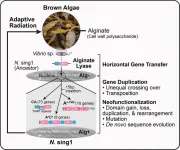(Press-News.org)
More than 150 million metric tons of propylene are produced annually, making it one of the most widespread chemicals used in the chemical industry.
Propylene is the basis for polypropylene, a polymer used in everything from medical devices to packaging to household goods. But most propylene is produced through steam cracking, a high-energy process that uses heat to break down crude oil into smaller hydrocarbons.
Now, Northwestern University chemists have found a way to create propylene using light. Their findings show that a nanoengineered photoactive catalyst can make propylene directly through a process called nonoxidative propane dehydrogenation (PDH).
The team found they could catalyze the reaction to create propylene and hydrogen from propane with a light-driven chemical process. If adopted at scale, the process could lead to lower emissions for the chemical industry, an important step toward industrial decarbonization.
The results were published today in the Journal of the American Chemical Society. First authors include graduate student Emma-Rose Newmeyer and postdoctoral scholar Yicheng Wang.
“Propylene is a behemoth of the chemical industry, and now we show that we can make it through reactions that are milder than those typically used,” said Northwestern’s Dayne Swearer, who led the study. “This proves that we can leverage designer nanoparticles in our progress toward a more sustainable future. If industry was able to use a renewable energy source like light in these catalytic processes, it could reduce overall energy demands even more.”
Swearer is an assistant professor of chemistry at Northwestern’s Weinberg College of Arts and Sciences and an assistant professor of chemical and biological engineering in the McCormick School of Engineering. He also is a faculty affiliate in the International Institute of Nanotechnology and co-chair of the Paula M. Trienen’s Institute for Sustainability and Energy’s Generate Pillar, which aims to develop a new class of solar energy production with high-efficiency materials. The Generate Pillar is part of the Trienens Institute’s Six Pillars of Decarbonization.
Making propylene by funneling light onto single atoms
To make propylene, scientists must break down the carbon-hydrogen bonds at the molecular level. “It doesn’t sound too hard because there are carbon-hydrogen bonds everywhere, but these are very stable bonds that are difficult to break,” Swearer said.
Because of increased natural gas availability in the United States through shale resources, the idea of PDH as a propylene manufacturing process has become more popular. Not only could it potentially be cheaper, but it could also reduce the need for crude oil resources and help the transition to renewable energy.
Yet scientists have struggled to find the right catalysts for this process that would reduce environmental impact.
For their study, Swearer and his team tested an unexplored idea: driving the reaction with a special type of nanoparticle that absorbs light but also has well-defined locations where a single atom catalyzes the reaction. The team created an alloy of copper and platinum—a combination known to be a good thermal catalyst—and tested what happened when they shined light onto it.
They found that when activated with a laser, the nanoparticles became excited and catalyzed the reaction to create propylene.
The team experimented with different amounts of alloyed platinum, along with the color and intensity of the light. They found that when they included isolated platinum atoms within copper nanoparticles, the structure funneled the light down to the isolated platinum atoms, enabling the carbon-hydrogen bond to break more easily.
“It’s this funneling of energy of the light onto single atoms that enables this reaction to take place,” Swearer said.
And though they tested systems with more platinum, the structures that included only single platinum atoms worked best — meaning this process would only need a small amount of a precious metal “without sacrificing reactivity and selectivity,” Newmeyer said.
An added bonus: the process also creates hydrogen at the same time, offering a secondary valuable byproduct.
A potential energy savings for industry
The team also found that they could reduce the overall temperature by 50 degrees Celsius (from standard operating temperatures) and get the same rate of conversion. That means that if this process were adopted by industry, it could result in major energy savings.
“It has the potential to heavily impact the emissions associated with chemical manufacturing by reducing the temperatures at which these industrial scale processes operate,” Newmeyer said.
Next, the team hopes to continue developing this catalyst and testing it with other processes that are important for making the building blocks of the chemical industry.
“There’s a lot of room to explore using these light-driven single atom alloys to drive different reactions,” Swearer said.
END
Mountain snowpacks accumulate snow throughout the winter, building up stores of water that will supply communities across the American West throughout the long dry season. Now, a new study shows that as storms carry snow to the Rocky Mountains, they are also bringing mercury and other contaminants from mines in the region. The research helps scientists understand how contaminants are spread by atmospheric circulation and has implications for snowpack preservation and illuminating the lasting environmental impact of mining activities.
The study, published in the May issue of the journal Environmental Pollution, examined contamination levels for ...
It can happen in an instant – a mother experiences a medical emergency during delivery that requires intensive care.
Meanwhile, her newborn infant is sent to the neonatal intensive care unit.
This early separation can greatly disrupt the establishment of adequate milk supply for those who want to breastfeed.
Recent research from the University of Michigan reveals that simple awareness on the part of the care team can help protect the breastfeeding relationship for patients in the ICU.
The work was spearheaded by Kayla Kolbe, M.D., clinical assistant ...
Jennifer L. West, Dean of the University of Virginia’s School of Engineering and Applied Science and the Saunders Family Professor of Engineering, has been awarded the 2025 Pierre Galletti Award, the highest honor from the American Institute for Medical and Biological Engineering (AIMBE).
West is recognized for her “innovative research in biomaterials and nanomedicine, her leadership in the field, and her dedication to mentoring the next generation of biomedical engineers.” The Galletti Award is named after AIMBE’s founding member and past president and recognizes a career-long commitment to advancing the field ...
Almost a decade ago, Harvard engineers unveiled the world’s first visible-spectrum metasurfaces – ultra-thin, flat devices patterned with nanoscale structures that could precisely control the behavior of light. A powerful alternative to traditional, bulky optical components, metasurfaces today enable compact, lightweight, multifunctional applications ranging from imaging systems and augmented reality to spectroscopy and communications.
Now, researchers in the Harvard John A. Paulson School of Engineering and Applied Sciences (SEAS) are doubling down, literally, on metasurface technology ...
A new study from Cedars-Sinai examined whether a specialized diet could improve symptoms of gastrointestinal disorders linked to an imbalance in gut microbiota.
The research tested the elemental diet’s effectiveness and explored whether improving its unappealing taste— a major barrier—could help patients adhere to the diet’s stringent protocol. The investigators’ findings were published in the peer-reviewed journal Clinical Gastroenterology and Hepatology.
The elemental diet is a special low-fat liquid formulation ...
Researchers tracked 89 Northern Saw Whet Owls (Aegolius acadicus) along a migration corridor in Western Montana, underscoring the efficacy of telemetry studies for detailed investigations into the movements of birds. Their paper, “Migration and Roosting Behavior of Northern Saw-whet Owls (Aegolius acadicus) During Fall Migration in Western Montana,” was published in the Journal of Raptor Research. The research team was surprised to discover that owls demonstrated stopover behavior, meaning pauses along migration for resting and refueling, as well as notable individual ...
Peking University, March 31, 2025: A simulation on the origin and evolution of North Atlantic Oscillation (NAO) has been conducted by a PKU research team led by Nie Ji, Associate Professor of School of Physics, and Hu Yongyun, Dean of Institute of Ocean Research, along with a research team from National Natural Science Foundation of China. Their study, recently published in Nature Communications, reveals the coherent relationship between NAO and the evolution of continents, mountains and oceans.
Why It Matters:
NAO plays a critical role in shaping climate patterns, affecting temperature, precipitation, and storms across regions like Europe, China, ...
Peking University, March 31, 2025: Professor Zeng Zexian’s team from the Center for Quantitative Biology at the Peking University Academy for Advanced Interdisciplinary Studies, in collaboration with the Peking University-Tsinghua University Joint Center for Life Sciences, has developed ICRAFT, an innovative computational platform for identifying cancer immunotherapy targets. Their study has been published in Immunity, an immunology research journal.
Why It Matters:
·There is an urgent need for precision immunotherapy strategies that simultaneously target both ...
BOSTON - April 1, 2025 - Most people donning virtual reality (VR) goggles are seeking the thrill of being immersed in a fictitious video game world. But some are donning them for an entirely different experience: to help researchers identify those most at risk of developing Alzheimer’s disease.
“We know that early detection of Alzheimer’s disease and other dementias can have a significant impact on the quality of life of the affected persons, through deployment of lifestyle changes and medications ...
A group of diatom species belonging to the Nitzschia genus, gave up on photosynthesis and now get their carbon straight from their environment, thanks to a bacterial gene picked up by an ancestor. Gregory Jedd of Temasek Life Sciences Laboratory, Singapore, and colleagues report these findings in a new study published April 1st in the open-access journal PLOS Biology.
Unlike most diatoms, which perform photosynthesis to generate carbon compounds, some members of the genus Nitzschia have no chlorophyll and instead ...




